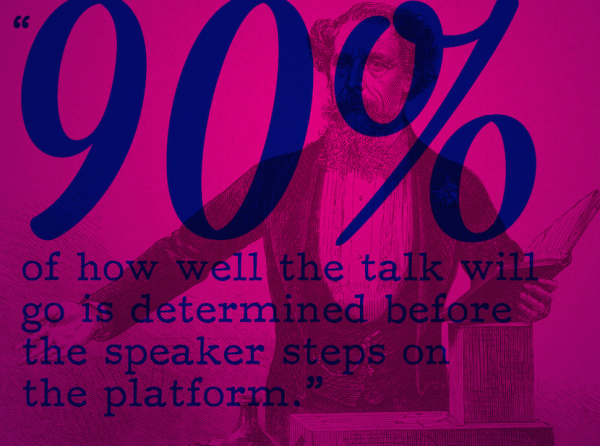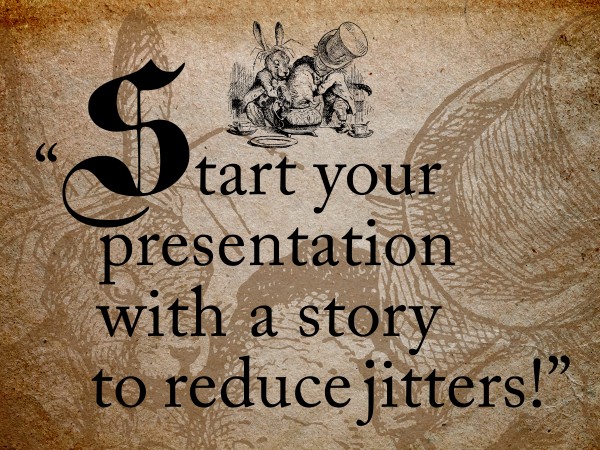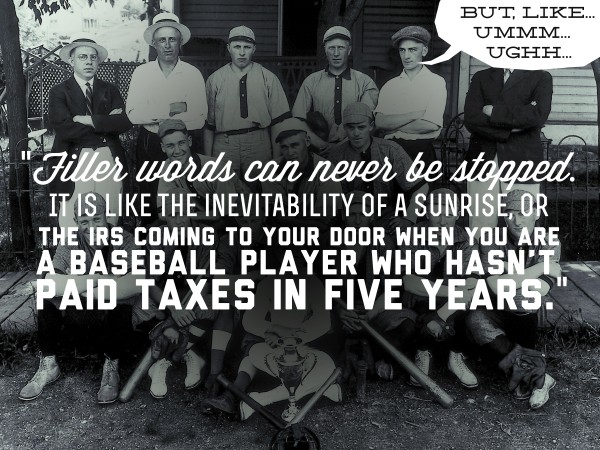“The human brain starts working the moment you are born and never stops until you stand up to speak in public.” – George Jessel
“Um’s,” “ah’s,” “like’s,” and “you know’s,” are often treated like the unwanted uncle at a family gathering. You can try to move him to the kid’s table or ask him to run a lengthy errand, but he’s still part of the family. While most of us try to seek a way to avoid these “filler” words, some psychologists have argued that they serve a purpose in conversation. Are we suggesting that Uncle Harry should finally have a place at the grown-up’s table? Absolutely. However, he should probably never have total control of the conversation.
How can a presenter learn to control the attack of “um’s” while still embracing that a few will probably fly? Can it ever be controlled? Will your presentations always sound like a telegraph? Stop. Read on. Stop.
Why It Happens
“According to the Oxford English Dictionary, the speech hesitation “hum” goes at least as far back as 1469. We also find “hem” from 1526, “haw” from 1679, and “er” from 1862. But these are only the first attestations of the words in print. It is likely that they go back much further than that.” (Source)
Verbal tics and filler words have been part of speech cadence since the first time we were able to make a coherent grunt. They can also be language-dependant, for instance, “eh” is a common filler in Spanish. Furthermore, they serve a very “human purpose” in speech and are not the result of anxiety as it is sometimes believed. For instance, “you are not more likely to use fillers when talking to a stranger than you are when talking to your spouse,” – The Art of Manliness, Becoming Well Spoken
Tics and other spontaneous parts of speech that would be considered a “typo” in writing is known in psychology as “disfluent.” Studies estimate that up to 6% of natural speech is disfluent, which is enough to have an impact on how meaning is processed. The theory as to why we say them suggests that they act as an unconscious way to signify meaningful markers during a conversation. Here are some of the different jobs that these verbal tics accomplish:
Pay Attention! – One positive way that filler words act is to signify that the speaker is about to share a new thought or some more information. This lets your audience know that they shouldn’t interrupt you, even if you are momentarily quiet.
Fill in the Blank – If a name is on the tip of your tongue, a well-placed “um” before the word can let your audience know that you need help or are allowing them to fill in that blank.
I’m Not 100% Certain – Filler words can also signify when you aren’t confident with a response. In fact, the more filler used while delivering an answer, the more likely that the answer will be incorrect.
The Word is On the Tip of My Tongue – If your audience isn’t planning to fill in the blank for a missing word, doesn’t know it, or can’t, filler signifies that your brain is picking the right word. This accomplishes the same job as a “loading” screen on a computer.
This Subject Is Tough – The more abstract the subject is, the more you are likely to rely on filler words fillers to share your message. For example, studies have shown that humanities professors say “uh” 4.76 times more per hundred words than professors of hard sciences at 1.47 times per hundred. “Overall, disfluency rates were higher both when speakers acted as directors and when they discussed abstract figures, confirming that disfluencies are associated with an increase in planning difficulty.” (Source study)
It could be argued that disfluent speech is another form of body language, like a twitch or a frown. No matter what language you speak or where you were raised, you will experience a form of verbal filler uniquely your own. From the “like” of a Valley Girl to the “uh” of a humanities professor, no one walks free from Filler Jail.
“Jeopardy contestants do better if they buzz first, when the question sounds familiar, and then access their memories afterwards, making sure that none of their rivals scoop them. The buzz is the equivalent of “Ah!” – Esther Inglis-Arkell
Can It Be Stopped?
“The argument is that uh and um are conventional English words, and speakers plan for, formulate, and produce them just as they would any word.” – “Using Uh and Um in Spontaneous Speaking” Stanford University, 2002.
It is in the expert opinion of this writer that sadly, filler words can never be stopped. It is like the inevitability of a sunrise or the IRS coming to your door when you are a baseball player who hasn’t paid their taxes in five years.
However, too many “um’s” and “like’s” can be distracting, diminish your credibility, and even annoy your audience. This is especially true as you deliver a presentation, where the audience doesn’t have the opportunity to step in and help you find the right words you may be searching for. Disfluency might also trigger the “this person is being dishonest” response in an audience if they feel like you are trying to buy time. If you can’t stop the verbal tics, the next best thing to do would be to reduce them so they don’t pose a distraction to your audience. How, you wonder?
Your Preparation Gameplan
At Ethos3, we are advocates of presentation practice. We may as well have the words “Practice” tattooed across all of our biceps. Two times the night before an event is simply not enough; how about 7+ times over the course of a week? When you consider that many instances of filler words are caused by the brain seeking words or expressing uncertainty, it makes sense to be prepared as humanly possible before a presentation.
Record Yourself – The first step is admitting you have a problem, right? It’s hard to identify your specific vocal filler during the time you are speaking, so consider recording yourself for a long period of time or even an entire speech to see which words you struggle with, and how frequently you experience disfluency.
Familiarize Yourself – The more familiar you are with your content, the less likely you will be to search for and create new ideas while you present. Memorization will make you sound robotic, but knowing all of your main points backwards and forwards will give you confidence.
Practice With A Person – Filler words send signals to your listener, which is why they increase during conversation when you did an excellent job in front of a mirror. Having a “real life person” listening to your presentation can prepare you for a room filled with them. Another cruel thing to try? Have your listener ring a bell or give you a signal every time you use a filler word.
One Thing At A Time – Because filler words can signify the brain searching for the right word or phrase, it makes sense to limit your distractions during a presentation and as you practice. The less on your mind, the less you’ll need to worry about assigning your cognitive load too much work. Avoid multi-tasking; focus on one thing at a time.
Tell a Story – The natural flow of storytelling reduces jitters and eliminates the worry that your brain will have to seek complex information. Consider opening your presentation with a short story to reduce anxiousness and keep the crowd focused.
Short Sentences or “Chunking” – Filler words can often bridge the gap between long sentences and ideas. In some ways, they act as the new line for a paragraph. Practice the art of “chunking” your main points, which simply means talking in short sentences with meaningful pauses in between. Not sure what that means? Check out this video that demonstrates it.
Worry, But Not Too Much
Filler words happens. It’s going to happen during your most important presentations and then later that night when you are trying to order a fast food hamburger. While you should be mindful of how much you are using an “um,” consider that the more nervous you are about it, the more it will happen. So relax! Drink some water before your presentation, make sure you don’t go in hungry, and if you have done your homework and practiced, your “um’s” should be minimal.
Question: Which filler words do you struggle with?



